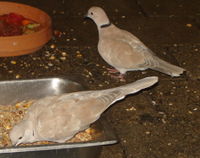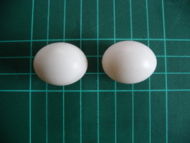|
Ringneck Dove |

|
|
Scientific classification |
| Kingdom: |
Animalia
|
| Phylum: |
Chordata
|
| Class: |
Aves
|
| Order: |
Columbiformes
|
| Family: |
Columbidae
|
| Genus: |
Streptopelia
|
| Species: |
S. risoria
|
|
|
Binomial name |
Streptopelia risoria
Linnaeus, 1758 |
The Ringneck Dove, Ring Dove, or Barbary
Dove, Streptopelia risoria, is a small domestic
dove.
Although the Ringneck Dove is normally assigned its own
systematic name, as Streptopelia risoria,
considerable doubt exists as to its appropriate
classification. Some sources confidently assert that it is a
domestic form of the
Eurasian Collared Dove, S. decaocto, but the majority of
evidence points to it being a domesticated form of the
African Collared Dove, S. roseogrisea. It appears that it
can hybridise freely with either species, and its status as
a species must therefore be regarded as doubtful. However
because of the wide use of both the common and systematic
names, it is best to consider it separately from either of
the putative parent species.
Ringneck Doves have been domesticated for 2000 to 3000
years. They are easily kept, and long-lived, in captivity,
living for up to 12 years, and are noted for their gentle
nature. In recent years they have been used extensively in
biological research, particularly into the hormonal bases of
reproductive behaviour, because their sequences of
courtship, mating and parental behaviour have been
accurately described and are highly consistent in form. Dove
fanciers have bred them in a great variety of colours; the
number of colours available has increased dramatically in
the latter half of the twentieth century, and it is thought that this has been
achieved by interbreeding with S. roseogrisea.
The coo of the ringneck dove is created by muscles
that vibrate air sent up from the dove's lungs. These
muscles belong to the fastest known class of vertebrate
muscles, contracting as much as ten times faster than
muscles vertebrates use for running. This class of muscles
is usually found in high speed tissue such as a
rattlesnake's tail. Ringneck doves are the first bird
species to have been found to have this class of muscle. (Elemans,
et al., 2004)
Feral populations of Ringneck Doves establish themselves
readily as a result of escapes from captivity, but they will
merge with local populations of Collared Doves if they
exist. There is a small feral population in Los Angeles,
California, where neither S. decaocto nor S.
roseogrisea is currently found.

Barbary dove eggs on 1 cm grid
References
- Elemans CP, Spierts
IL, Muller UK, Van Leeuwen JL, Goller F (2004). "Bird
song: superfast muscles control dove's trill".
Nature 431 (7005): 146.
- Oliver, K. Wade (2005).
Ringneck Doves: A Handbook of
Care and Breeding.
External links




